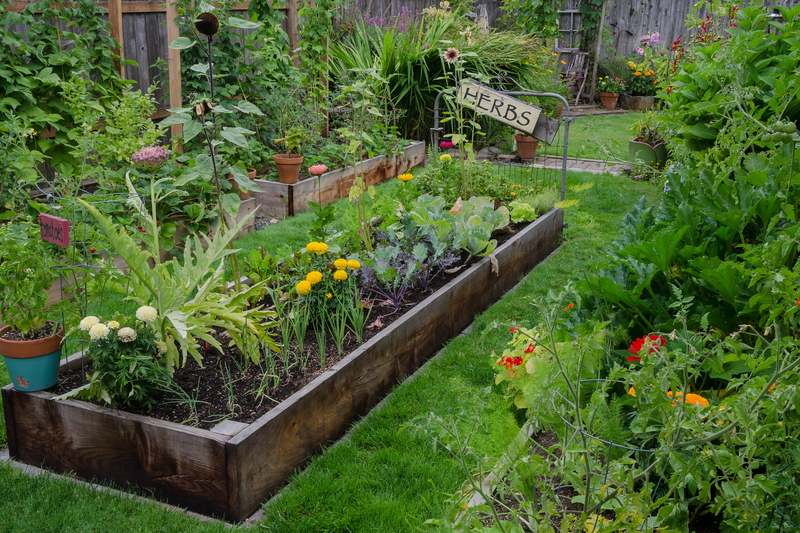How to Create a Vibrant and Productive Herb Garden
Posted on 14/08/2025
How to Create a Vibrant and Productive Herb Garden
Are you dreaming of a flourishing and aromatic garden brimming with fresh herbs? Herb gardening is an enjoyable, rewarding, and cost-effective way to enhance your culinary creations, beautify your outdoor space, and even boost your wellbeing. In this comprehensive guide, you will discover everything you need to know about creating a vibrant and productive herb garden right at your fingertips.

Why Start a Home Herb Garden?
Growing herbs at home offers a series of compelling benefits:
- Save Money: Fresh herbs from the supermarket can be costly, but homegrown ones are practically free after your initial setup.
- Easy Access: Enjoy instant access to flavorful herbs whenever you cook, brew tea, or want to decorate a dish.
- Therapeutic Values: Gardening reduces stress and connects you with nature.
- Attractive Scenery: Herbs add greenery and delightful scents to your space.
- Eco-Friendly: Reduce your environmental footprint by growing your own food.
Whether you have a sprawling backyard or a tiny balcony, you can establish a lush and productive herb garden that suits your needs.
Step 1: Choose the Ideal Location for Your Herb Garden
Selecting the right spot is crucial for your garden's success. To grow healthy herbs, you need to pay attention to:
Sunlight Requirements
Most herbs thrive with at least 6 hours of direct sunlight per day. Locations such as:
- South-facing windows
- Patios or balconies with ample sunlight
- Sunny spots in your backyard or rooftop gardens
If you're limited to shade, choose shade-tolerant herbs like mint, chervil, or parsley.
Soil Quality and Drainage
Herbs require well-draining, fertile soil. Avoid heavy clay or soggy soils as they can cause root rot.
- Tip: Mix compost or organic matter to enrich garden soil.
- For potted herbs, use a quality potting mix labeled for herbs or vegetables.
Accessibility and Convenience
Place your herb garden where you can reach it easily--close to your kitchen or grill for maximum usage and minimal effort.
Step 2: Decide: In-Ground, Raised Bed or Container Herb Garden?
Your ideal herb garden layout depends upon your available space, budget, and preferences.
- Traditional In-Ground Garden: Perfect for larger yards and allows for expansive planting.
- Raised Beds: Provide excellent drainage, easier access, and soil control--great for all gardeners, especially those with mobility issues.
- Container Herb Gardens: Ideal for patios, balconies, and small spaces. You can move them to "chase the sun" when needed.
Mix and match these approaches for a customized and productive herb space.
Step 3: Pick the Best Herbs for Your Garden
Beginner gardeners often ask, "Which herbs are easiest to grow at home?" While most herbs are straightforward, here are the best herbs for a productive garden:
- Basil: Essential for pesto & summer salads. Loves full sun and warm temperatures.
- Thyme: Perennial with delicate, robust flavor. Drought-tolerant and easy to maintain.
- Mint: Grows vigorously--ideal for tea, desserts, and cocktails. Plant in containers to control its spread.
- Parsley: Biennial that adds freshness to any dish. Prefers partial sun to slight shade.
- Rosemary: Woody, fragrant, and excellent for roasts. Thrives in hot, dry conditions.
- Cilantro (Coriander): Annual, grows quickly and is great for salads, salsas, and curries.
- Oregano: Perfect for pizzas & Mediterranean dishes. Easy and robust.
- Sage: Hardy and flavorful, pairs well with meats and winter stews.
- Chives: Great for eggs, potatoes, and dips. Tolerates a range of conditions.
- Dill: Annual, great for pickles and seafood dishes.
Bonus tip: Start with 3-5 of your favorite herbs to keep your herb garden manageable and focused as you learn.
Step 4: Planting Your Herb Seeds or Seedlings
Once you've selected your herbs, decide whether you'll grow from seeds or buy seedlings. Both options can produce a vibrant herb garden:
- Seeds: Inexpensive and offer a wide selection but require more patience.
- Seedlings: Instant gratification and quick harvests--perfect for beginners.
Planting Guidelines
- Follow packet or label instructions on spacing and depth.
- Keep soil moist (not soggy) until seeds sprout or seedlings establish roots.
- Harden off seedlings before transplanting outdoors.
- Add a layer of mulch to retain moisture and suppress weeds.
Tip: Group herbs with similar needs together for best results.
Step 5: Care and Maintenance for a Thriving Herb Garden
Routine care will keep your herb garden productive and colorful throughout the season. Here's how to maintain healthy, vigorous herbs:
Watering
- Water most herbs when the top inch of soil feels dry.
- Water deeply but less frequently to encourage strong roots.
- Avoid overhead watering to prevent fungal diseases.
Fertilizing
- Light feeders: Most herbs need only minimal fertilizer.
- Feed with a diluted, organic fertilizer once every 4-6 weeks during active growth.
Over-fertilizing can reduce the flavor of many culinary herbs!
Pruning & Harvesting
- Pinch back young herbs to encourage bushiness and reduce flowering.
- Harvest frequently: Regular picking promotes new growth and increases yields.
Tip: Never remove more than one-third of the plant at a time to keep your herbs healthy and productive.
Pest & Disease Management
- Monitor for common pests like aphids, spider mites, and snails.
- Encourage beneficial insects such as ladybugs.
- Remove diseased leaves promptly to stop the spread.
- Plant basil and chives near tomatoes for natural pest control.
Organic solutions keep your herb garden safe and eco-friendly!
Step 6: Maximizing Productivity and Vibrancy
Want a truly beautiful and productive herb garden that provides all season long? Consider these pro gardener strategies:
- Succession Planting: Sow new seeds every few weeks to ensure a steady supply.
- Mix Perennial and Annual Herbs: Perennials like rosemary, thyme, and sage offer structure year-round; annuals spark vibrant color and quick harvests.
- Companion Planting: Some herbs enhance each other's growth--basil repels pests from tomatoes, parsley attracts beneficial hoverflies.
- Mulch for Moisture: Organic mulch retains water and keeps roots cool in hot weather.
- Rotate Containers: Move pots to chase sunlight or bring sensitive herbs indoors during harsh weather.
With thoughtful planning, your herb patch will be both productive and aesthetically pleasing.
Step 7: Harvesting and Storing Your Garden Herbs
Harvesting herbs at the right time guarantees the best flavor, fragrance, and nutrition. Here's how:
When to Harvest
- Pick herbs in the morning after dew evaporates but before it gets hot.
- Harvest leafy herbs (basil, parsley, mint) before they flower for the most intense flavor.
- Cut only the young, healthy stems and leaves.
How to Store Herbs
Enjoy your harvest fresh, or store for future use:
- Refrigerate: Place in a glass of water, cover loosely with a bag, and refrigerate for up to a week.
- Drying: Hang small bunches in a cool, dark, well-ventilated space for 1-2 weeks, then store in airtight containers.
- Freezing: Chop herbs and place in ice cube trays with water or olive oil for convenient use.
- Infusion: Make herb oils, vinegars, or butters for delicious flavor boosts in your kitchen.
Design Tips for a Beautiful Herb Garden
- Define borders with bricks, stones, or decorative edging.
- Use vertical gardening solutions like hanging baskets or wall planters for tight spaces.
- Mix colors and textures: Pair purple basil with silvery sage, or variegated thyme with lush parsley.
- Intersperse edible flowers like nasturtiums or calendula among herbs for added color and pollinator appeal.
- Label your herbs with handmade signs for both charm and practicality.

Common Problems & Solutions for Your Herb Garden
Struggling with your vibrant and productive herb garden? Here are common issues and fixes:
- Leggy Growth: Herbs aren't getting enough sun--move them to a brighter location.
- Yellow Leaves: Could indicate overwatering; ensure soil drains well.
- Poor Flavor: Over-fertilizing or letting herbs flower may weaken taste; fertilize sparingly and pinch buds.
- Wilting: Check soil moisture; herbs may dry out quickly in hot weather or exposed pots.
- Pests: Spray with gentle solutions like soapy water, or remove by hand.
Conclusion: Enjoy the Rewards of Your Flourishing Herb Garden
Creating a vibrant and productive herb garden gives you fresh, delicious flavors at your fingertips year-round--plus beauty, relaxation, and sustainability. With careful plant selection, proper care, and a dash of creativity, any gardener can cultivate herbs successfully whether in a backyard, patio, or windowsill.
- Start small with 3-5 herbs you use most.
- Choose the right location, soil, and container for your space.
- Water, prune, and feed wisely to grow lush, robust plants.
- Mix beauty and productivity for a truly vibrant herb garden!
Don't wait--plant your first seeds today and transform your home with a thriving herb haven!

